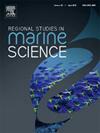克罗地亚普里莫列-戈尔斯基科塔尔县凹陷海岸线的海岸脆弱性指数
IF 2.1
4区 环境科学与生态学
Q3 ECOLOGY
引用次数: 0
摘要
这项研究探讨了海岸线的总体脆弱性,重点是在克罗地亚普里莫列-戈尔斯基-科塔尔县 (PGC) 高度内凹的海岸线上使用海岸脆弱性指数 (CVI) 评估脆弱性。在全长 1235 公里的海岸线上,每隔 25 米就有一个脆弱性评估点,根据地质环境、与地形不稳定性(岩崩和滑坡)有关的海岸坡度、显著波高、沿岸洪水和海滩这五个代表性变量计算沿海脆弱性指数,并将其整合为一个整体的沿海脆弱性指数。海岸线的长度、不同的地貌特征以及可用数据的规模要求对常用方法进行调整。结果表明,海岸线的整体脆弱性较低,这主要是由于海岸线上普遍存在相对抗蚀的碳酸盐沉积岩。然而,在所调查的海岸线中,几乎有四分之一极易或非常易受沿海洪水的影响。特别值得关注的是,许多最脆弱的地区都有人居住。这种规模的分析适用于区域空间规划。研究成果可在网上公开获取,从而可实际应用于沿海地区的规划和管理。适应气候变化的影响在很大程度上取决于地点本身,但总体而言,该评估提供了 PGC 最脆弱地点的指示,有必要限制对沿海地区的干预。本文章由计算机程序翻译,如有差异,请以英文原文为准。
Coastal vulnerability index for the indented coastline of Primorje-Gorski Kotar County, Croatia
The study explores the general vulnerability of the coastline, with a focus on assessing vulnerability using the coastal vulnerability index (CVI) along the highly indented coastline of Primorje-Gorski Kotar County (PGC), Croatia. Vulnerability was assessed every 25 m of the 1235 km long coastline by calculating the CVI based on five representative variables: geological setting, coastal slope in relation to terrain instabilities (rockfalls and landslides), significant wave height, coastal flooding, and beaches, which were also integrated into a single overall CVI. The length of the coastline, characterised by different relief forms, and the scale of available data required an adaptation of the commonly used methodology. The results show a low overall vulnerability, mainly due to the prevalence of relatively resistant carbonate sedimentary rocks along the coasts. However, almost a quarter of the investigated coastline is highly or very highly vulnerable to coastal flooding. Of particular concern is the fact that many of the most vulnerable areas are inhabited. Analyses at this scale are suitable for regional spatial planning. The results of the conducted research are available publicly online, which enables their practical application for planning and management of coastal areas. Adaptation to the impacts of climate change is highly dependent on the location itself, but overall, this assessment provides indications of the most vulnerable locations in the PGC, where it is necessary to limit interventions in the coastal area.
求助全文
通过发布文献求助,成功后即可免费获取论文全文。
去求助
来源期刊

Regional Studies in Marine Science
Agricultural and Biological Sciences-Ecology, Evolution, Behavior and Systematics
CiteScore
3.90
自引率
4.80%
发文量
336
审稿时长
69 days
期刊介绍:
REGIONAL STUDIES IN MARINE SCIENCE will publish scientifically sound papers on regional aspects of maritime and marine resources in estuaries, coastal zones, continental shelf, the seas and oceans.
 求助内容:
求助内容: 应助结果提醒方式:
应助结果提醒方式:


